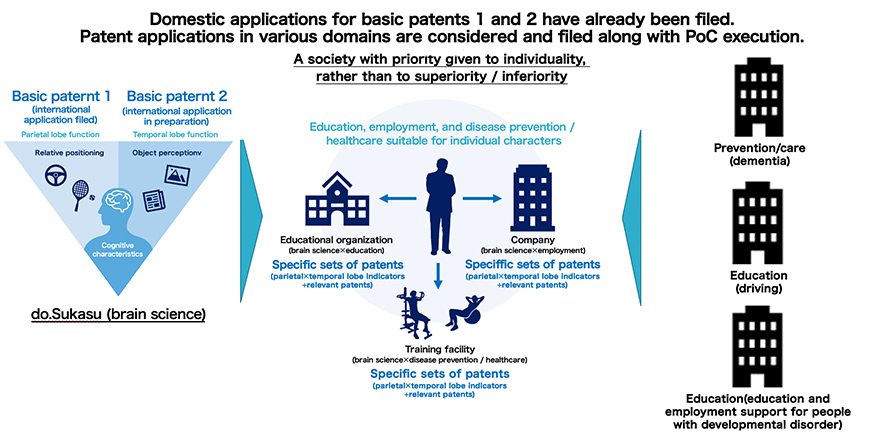do.Sukasu Co., Ltd. (hereinafter do.Sukasu) is a company that is developing the “VR de.Sukasu” visual space perception ability* evaluation system and other products that can be easily and enjoyably used by everyone by means of brain science approaches. The company is working on technology and business developments in a wide range of fields, including healthcare, education, automobile driving, and exercise, with a mission statement of “Create a Society with Priority Given to Individuality, Rather Than to Merits and Demerits.”
*“Visual space perception ability” is the ability to visually perceive “object position, sense of distance, and perspective sensation.” Details are described below.
do.Sukasu was born through collaboration between Sumitomo Dainippon Pharma Co., Ltd. (hereinafter Sumitomo Dainippon Pharma) and Co-Studio, Inc., showing a presence in the development of co-creation-type new businesses. It was founded in June 2020 to socially implement patented technology for evaluation of visual perception. Its management board includes CEO Kazuki Kasai, an inventor of the patented technology from Co-Studio, Inc., and CTO Yasushi Ochiai, another inventor, from the Frontier Business Office of Sumitomo Dainippon Pharma.
This corporate structure is based on a strategy of Sumitomo Dainippon Pharma’s Dejima to produce innovative ideas through collaboration with outside entities, i.e., a new business development policy called the “excubation type,” compared with the incubation type.
The patent rights for the visual perception evaluation are possessed by Sumitomo Dainippon Pharma. Working together to “create a society with priority given to individuality,” do.Sukasu verifies hypotheses and identifies business opportunities speedily for a startup company, and Sumitomo Dainippon Pharma provides potential business targets and knowledge in the medical services and healthcare field.
This article describes “VR de.Sukasu,” a tool for objectively and quantitatively evaluating individual “visual perception ability” and finding its patterns, so as to create a society in which people who are perceived as “different from normal” can live more actively.
Realizing a Society in which “Different-from-Normal People” Can Be Active
Creating a Society with Priority Given to Individuality

While the terms “diversity” and “comprehensiveness” are often used nowadays, there is no reasonable common recognition as to “what forms of diversity exist.” In a society implicitly based on “normalcy,” many people who are perceived as “different from normal” are struggling in areas where their difficulties are unlikely to be noticed by “normal people.”
Sumitomo Dainippon Pharma and do.Sukasu consider that modern Japan stands on a social system optimized for “normal people,” who are the majority, and thus it is difficult for people with distinct abilities or personalities to manifest their potential abilities, and to live their life with self-confidence and self-esteem.
In addition, the non-utilization of the wide variety of abilities of people who are “different from normal” poses a great loss to our society. According to an estimation by Nomura Research Institute, Ltd., the economic loss from a lack of support for people with developmental disorders in Japan amounts to 2.3 trillion yen, and is even 2.5 times greater if potential subjects are included1). If supportive measures are taken for people with developmental disorders, the productivity will improve by 117% compared with the overall mean1). In addition, the Keio University School of Medicine estimates the social cost from a total of developmental disorders and the inability of patients with dementia to care for themselves amounts to 14.5 trillion yen2).
Social Issues do.Sukasu Is Tackling

In what kind of society would such “different-from-normal people” be able to live while manifesting their abilities? Sumitomo Dainippon Pharma held a broad range of discussions and reached a conclusion that emphasis should be placed on society considering individual personalities, rather than the self-adaptation of the individuals to society. If “normalcy” in society is dispersed from around its center, “different from normal” will no longer exist, and individuality will work autonomously.
Then, a question arose: “What is necessary for our society to change, with priority given to individuals?” One answer is that the first step should be to visualize personal differences, and to promote the mutual understanding of individual personalities. Hence, Sumitomo Dainippon Pharma considers it is key to accurately understand the personality of each person.
First, do.Sukasu noted “visual perception ability” as a characteristic of individuality. Individual human beings have distinct abilities to look at an object and judge what it is. If we understand a person’s own views and patterns in watching the world, the person’s individuality can be evaluated objectively. This idea led do.Sukasu to the invention of new technology for accurately evaluating the visual perception of each person.
Understanding Personalities based on Individual Visual Perception Abilities
Focusing Point: Visual Perception Abilities

According to the theory of multiple intelligences proposed by the psychologist Howard Earl Gardner3), there are eight human abilities, and suitable occupations are available for each ability. In addition, human ability reportedly depends on the brain; it is said that if brain function is fully understood, we will be able to visualize the abilities objectively.
Different persons have different ways of processing information in the brain, such as in communication and the ways they memorize human faces. Therefore, it seems possible to propose skills suitable for individual persons by understanding the information processing characteristics of the brain. Hence, do.Sukasu aims to identify and present the characteristics of individuals by “looking through” visual perception as the brain’s visual characteristic.
There are two forms of visual perception ability: object perception ability and visual space perception ability.
Visual space perception ability is the ability to perceive “object position, sense of distance, and perspective sensation.” This characteristic allows the person to understand in which direction and at what speed an object is moving when watching it. By doing so, the person can realize whether the object may pose danger, and make a judgement in response.
Object perception ability is the ability to perceive “lines, figures, and characters.” This ability enables the person to instantaneously recognize an object based on its color, shape, and pattern.
Visual space perception ability and object perception ability both fall under the same scope of visual perception ability. In reality, however, different brain areas are active during information processing for the respective abilities. The parietal lobe is active in visual space perception, whereas the temporal lobe is active in object perception.
Discussion: Mental Rotation Tasks

These two capacities can be measured by, for example, “mental rotation tasks.” This is a test in which the subject is directed to find out 10 “right hand” prints among the 20 hand prints in the illustration at left. Some subjects can find matching prints by rotating the illustration, and others can instantaneously understand the directions of the right hand without rotating the illustration; this difference determines which brain area is more active than other areas.
In the test, brain waves are measured while the subject is performing mental rotation tasks. Some subjects search for right hand prints while rotating the illustration, showing that the parietal lobe of the brain (visual space perception ability) is active. In subjects who can find right hand prints all at once, the temporal lobe of the brain (object perception ability) is active. This means that even when looking at the same object, persons who are object perception dominant and those who are visual space perception dominant perceive the object differently.
Hence, different areas of the brain are activated depending on the ease of information processing in the person. Noting this variation in brain activity pattern, do.Sukasu considers that individuality can be assessed by objectively evaluating the visual perception ability pattern of each person. Currently, the company is working every day to study new indicators for evaluating visual space perception ability through businesses and technical verifications encompassing multiple domains.
Evaluating Visual Perception Ability Using Virtual Reality Technology
Currently, do.Sukasu is developing the “VR de.Sukasu” software system to enable easy and quick evaluations of visual space perception ability using virtual reality (VR) technology. do.Sukasu aims to create a society in which people who are perceived as “different from normal” can live actively by identifying and presenting the characteristics of everyone’s brain, and proposing specifically suitable contents.
VR technology is particularly effective in the evaluation of visual space perception ability. While conducting research, do.Sukasu found patterns of very high correlation between human behaviors and visual space perception ability. In addition, do.Sukasu believes it is possible to estimate the visual space perception ability of a person by sensing their behaviors in a VR space.
This estimation is described below, in reference to the function “VR de.Sukasu KEEP.” When the subject puts on the VR headset, a movie of “chasing a target in front of them” is presented. The subject is asked to approach the object at a distance of 20 meters, for example, and to learn that “this is a 20-meter distance.”
A demonstration of “VR de. Sukasu KEEP”
Thereafter, the object begins moving, and the subject keeps a 20-meter distance from the object for 60 seconds. This is repeated in three sets. This content is to check whether the subject can keep the distance for the specified time, and the visual space perception ability is evaluated on the basis of the check results.
In another function, “VR de.Sukasu CATCH,” the visual space perception ability is measured by a simple operation of breaking soap bubbles flying toward the player. It enables an evaluation as if in an ordinary game by measuring the number of successes and the discrepancies (distances) from the bubbles. Standing on a scientific principle, do.Sukasu makes constant efforts to improve the design for receiving measurements in ways that are enjoyable to the subject.
A demonstration of “VR de. Sukasu CATCH”
A product for measuring object perception ability, called “Tab le.Sukasu FIND,” is also under development. In FIND, a tablet computer is used to perform actions to find a specified object from among many superposing objects. do.Sukasu expects that the visual perception ability will be analyzed comprehensively through measurements made using the “de.Sukasu KEEP” and “de.Sukasu CATCH” VR functions, and also measuring the object perception ability using the “le.Sukasu FIND” function for tablet computers.
A Broad Range of Business Operations, from the Automotive Industry to Support for Persons with Dementia or Developmental Disorder
Target for First Business Development(Application of VR-based Evaluation Technology)

do.Sukasu is also considering another business development based on such VR-based evaluation technology. An application for evaluation of visual space perception ability in automobile driving is being planned.
Distance perception is key to driving a car. At present, there is a social concern about the “driving ages” of elderly drivers; the probability of causing traffic accidents increases with decreasing visual space perception ability due to aging. To cope with this issue, do.Sukasu is developing a method for increasing the driving ages of the elderly by routinely evaluating the driver’s visual space perception ability based on driving records and other information, and drawing up an appropriate training care program.
In the car driving field, product development can be feasible based on evaluations of visual space perception ability alone; this feature allows ventures to quickly start their services. In its short-term business plan, do.Sukasu will focus on the use of visual space perception ability in the automotive industry. The first targets will be ability evaluations and training sessions at driving schools and for users of commercial vehicles and general vehicles.
Specifically, do.Sukasu entered into collaboration with OFA-SUPPORT Inc., a company in healthcare and driving-related businesses, in February 2021. The company commenced a demonstrative project to apply their brain characteristic visualizing technology to healthcare services and driving-related operations. do.Sukasu acquires and analyzes brain characteristics and driving data from OFA-SUPPORT’s customers using “VR de.Sukasu,” and determines whether they could be applied to new businesses in healthcare services and driving-related operations in this era of dementia.
To cope with visual perception issues in people with developmental disorders, do.Sukasu is collaborating with I’m Inc., a company that operates welfare facilities for mentally disordered persons, including after-school day services and daily life care. do.Sukasu is also exploring a method for providing objective evaluations and vision training to enhance visual perception for children with attention deficit hyperactivity disorder (ADHD) or learning disorder (LD) having “difficult vision” in literacy and sports, and children with autism having “distortions” in their visual perception.
do.Sukasu's Intellectual Property Strategy

Another strength of do.Sukasu resides in its strategic approach to intellectual property. do.Sukasu files applications for basic patents in the business planning stage, and if any invention is found to be promising in the developmental and operational stage, the company will soon file additional applications to increase its applicability. do.Sukasu considers this intellectual property strategy as key to make themselves distinct from general ventures, and wants to apply it to business operations in dementia prevention and care and support for education and employment of people with developmental disorders on a middle- to long-term basis.
In its middle- to long-term business plan, do.Sukasu is seeking a broad range of business developments, from services for the elderly and handicapped people (including development evaluations and development support training at development support facilities for children with disabilities; daily life support, rehabilitation, job-finding support, and human resource development for the elderly at long-term care facilities; and sports gym operations and health promotion trainings), to services that will be helpful to healthy persons.
As a part of our technical policy, do.Sukasu aims to enable evaluations of visual space perception ability without using VR in the future. While conducting vigorous research, we at do.Sukasu found highly correlating patterns between human behaviors and visual space perception ability. Hence, visual space perception ability may be estimated simply by sensing human behaviors without wearing a VR headset. We will proceed to work on relevant technical developments.
In addition, at the Frontier Business Office of Sumitomo Dainippon Pharma Co., Ltd., we are endeavoring to conduct research and development for new values and business by combining our knowledge that has been compiled through R&D activities for pharmaceuticals for neuropsychiatric diseases and unique technologies, findings, and patents of our business partners. Please contact us to talk about your wish and potential for collaboration as our business partner.
< Data Sources >
- 1)Nomura Research Institute, Ltd.: Increasing Opportunities for Persons with Developmental Disorders in Digitization Society and Their Economic Impact.
- 2)Keio University: A Study on the Economic Impact of Dementia in Japan, Fiscal 2014 Final Substudy Report.
- 3)Onishi Y: Rethinking Multiple Intelligences Theory in the Age of Globalism: A Preliminary Study and a Proposal for Further Research (in Japanese), In Journal of Studies on Humanities and Public Affairs of Chiba University. Vol. 38, pp. 277-291.
Contact us
-
Inquiry Form
-
Tokyo, JAPAN
Frontier Business Office
Sumitomo Pharma Co., Ltd.
Tokyo Nihombashi Tower,
2-7-1, Nihonbashi, Chuo-ku,
Tokyo 103-6012, Japan
Reception: 7th Floor -
Cambridge, USA
Frontier Business Office
Sumitomo Pharma America, Inc.